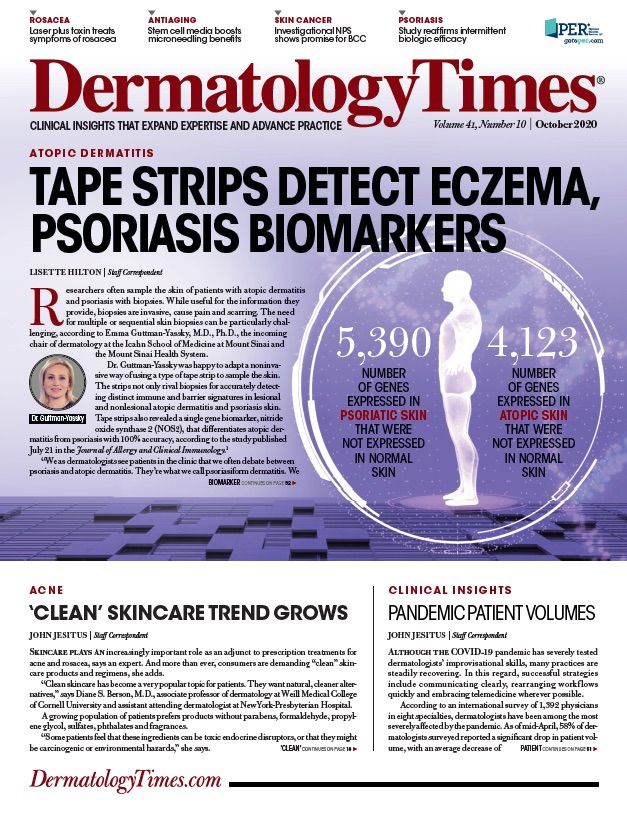- Case-Based Roundtable
- General Dermatology
- Eczema
- Chronic Hand Eczema
- Alopecia
- Aesthetics
- Vitiligo
- COVID-19
- Actinic Keratosis
- Precision Medicine and Biologics
- Rare Disease
- Wound Care
- Rosacea
- Psoriasis
- Psoriatic Arthritis
- Atopic Dermatitis
- Melasma
- NP and PA
- Skin Cancer
- Hidradenitis Suppurativa
- Drug Watch
- Pigmentary Disorders
- Acne
- Pediatric Dermatology
- Practice Management
- Prurigo Nodularis
- Buy-and-Bill
Publication
Article
Dermatology Times
Managing pandemic patient volumes
Author(s):
Since the start of the pandemic, dermatologists have seen an average 50% drop in patient volume. While teledermatology has offered a channel for non-urgent patients and patient visits are rebounding, overall patient volumes are still significantly lower than 2019.
Although the COVID-19 pandemic has severely tested dermatologists’ improvisational skills, many practices are steadily recovering. In this regard, successful strategies include communicating clearly, rearranging workflows quickly and embracing telemedicine wherever possible.
According to an international survey of 1,392 physicians in eight specialties, dermatologists have been among the most severely affected by the pandemic. As of mid-April, 58% of dermatologists surveyed reported a significant drop in patient volume, with an average decrease of 50%, second only to cardiology.1
“We know that every patient is having a different experience and taking a different approach to in-office dermatology appointments, depending on their region, government regulations and personal comfort levels,” says Rhonda Peebles, vice president and head of U.S. Dermatology for UCB.
“One thing we can all agree on is that the normal rules of engagement are a thing of the past. And UCB is thinking through the lens of the future to anticipate what a post-pandemic world will look like for healthcare, so we can adjust our support strategies for clinicians and patients in an appropriate way,” Ms. Peebles adds.
When California’s shelter-in-place order began March 17, says Wendy Roberts, M.D., “Everything came to a screeching halt. People were canceling in droves.” She is a dermatologist and dermatopathologist in solo private practice in Rancho Mirage, Calif.
That afternoon, Dr. Roberts sent her patients a lengthy email.
“In times of crisis, you have to communicate with your patients — not your staff, you, the doctor,” she says.
She reassured patients, encouraging them to do what they felt comfortable with. She also told patients that, being essential per U.S. Centers for Disease Control guidelines, her medical practice would remain open.
That same day, she rearranged her 6,500-square-foot office. The new workflow starts with calling patients before their appointment to check their COVID-19 status and, once they arrive, whisking them from their cars to an exam room — without ever encountering another patient.
“There’s no reception. You come right into your room. We’re all in personal protective equipment (PPE) — me, the staff, everybody,” she says.
Post-visit, patients check out from their exam rooms and leave the practice via an exit-only door.
Dr. Roberts says that she and her patients like the new system so well that she’s not switching back.
“By April 1, I was back in full swing. And I haven’t stopped,” she says.
In fact, her patient volume has grown approximately 15% thanks to new patients who found her when their regular doctors’ offices were closed.
Other dermatologists have shown similar resourcefulness in staying afloat during the pandemic.
“We have to be mindful,” says Adam Friedman, M.D. “We’ve removed chairs from the waiting room to limit how many people could be out there.” He is professor and interim chair of dermatology at George Washington University School of Medicine and Health Sciences.
As a medical institution, the university has implemented rigorous safety protocols everywhere.
“Every person who walks through the door gets screened for temperature. They’re asked questions. No one is allowed in the building without a mask,” Dr. Friedman says.
Throughout the facility, signage shows patients where to wait for elevators and where to stand before the massive Plexiglas shields that guard each front desk.
Telemedicine to the rescue
Equally important to dermatologists’ pandemic response was implementing telemedicine. Dr. Friedman says that riding out the pandemic has been “a bit of a roller coaster.” In response to waivers of governmental and insurers’ restrictions on telemedicine, however, his department quickly adopted the technology.
“Even though we were still able to have clinical productivity, it was a fraction of what we were pre-COVID,” he says. “But it revved up pretty fast. We were seeing hundreds, and then several thousand telehealth visits.”
Joel Schlessinger, M.D., says that through the end of April, his business was down easily 75%. He is an Omaha, Neb.-based board-certified dermatologist and cosmetic surgeon and CEO of LovelySkin. While his cosmetic practice shut down for three months, he swiftly began funneling non-urgent medical appointments to teledermatology.
“That allowed us to decrease the density of people in the office,” he says.
During the heart of the shutdown, he and two PAs saw a total of 50 telemedicine patients daily.
Dr. Schlessinger adds, “We kept our entire staff employed during the lockdown. And it was very challenging during that time. We were extraordinarily fortunate that we were able to get the Paycheck Protection Program (PPP) money within a matter of a month or so. That was our lifeline.”
As guidelines eased, Dr. Schlessinger began reopening in May, asking elderly and immunocompromised patients with non-urgent concerns to stay home until the pandemic is at least somewhat controlled. Over time, he has increased in-office appointments for non-urgent concerns while decreasing teledermatology visits to five to 10 appointments per day.
Dr. Friedman says that once his practice could open its doors to nonemergency patients, a “mad dash” of patients flipped the bulk of appointments back to the in-person variety. Common reasons for visiting include full-body skin cancer checks, which were prohibited via telehealth, plus follow-up on inflammatory skin diseases. A surprising number of patients just wanted to chat, he adds, because they had not left their homes in months.
Due to safety requirements, Dr. Friedman cannot see nearly as many in-office patients as remote patients per day. But after getting into the groove, he sees one patient every 15 minutes for a total of approximately 26 patients daily (his pre-pandemic average was 30). By late August, practice-wide patient volumes had reached approximately 90% of pre-pandemic levels.
Dr. Schlessinger says that his medical and aesthetic practices have rebounded to varying degrees. Many existing and new patients are scheduling cosmetic procedures, he adds, after watching their faces on Zoom screens for countless hours.
Although his cosmetic business is growing month-by-month, cosmetic revenues remain significantly down versus 2019.
“If things continue as they are, we may come close to even by the end of the year,” he says. “We’re still running at about 75% to 80% of our maximum compared to pre-pandemic,” he adds.
This situation likely will persist at least until the pandemic is under control or a vaccine emerges, he says.
References:
1. Sermo. COVID-19 HCP sentiment surveys part one: physician engagement with patients and remote/telehealth experiences. https://www.sermo.com/hcp-sentiment-study-series/. Published April 2020. Accessed September 1, 2020.
Disclosures:
Drs. Roberts, Friedman and Schlessinger report no relevant financial interests. Ms. Peebles is an employee of UCB.






